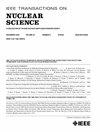Research and Development of a Commercial Passive Fast Neutron Multiplicity Counting Device for Nuclear Material Accounting
IF 1.9
3区 工程技术
Q3 ENGINEERING, ELECTRICAL & ELECTRONIC
引用次数: 0
Abstract
A commercial passive fast neutron multiplicity counting (FNMC) device has been developed by our group. The device mainly consists of 32 self-developed EJ-301 liquid scintillation detectors arranged in a spherically symmetrical configuration. These detectors are read out by a 32-channel electronics system equipped with an online field-programmable gate array (FPGA) neutron-gamma discrimination function. In addition, the device integrates a self-designed graphical user interface (GUI), enabling interactive operations such as control and monitoring of the readout electronics and high-voltage power supply. The one-parameter calibration and three-parameter assay methods are used for data analysis to estimate the mass of various 252Cf neutron sources. The results show that the device can accurately measure the mass of 252Cf neutron sources (with an equivalent 240Pueff mass range of 7.84–1929.15 g). Additionally, the three-parameter assay method is used to estimate the 240Pueff mass of four PuO2 samples, and the relative deviations (RDs) between estimated and true 240Pueff mass and relative uncertainties are all less than ±4.5% and 2.75%, respectively.用于核材料核算的商用无源快中子多重计数装置的研究与开发
本课程组研制了一种商用无源快中子多重计数(FNMC)装置。该装置主要由32个自行研制的EJ-301型液体闪烁探测器组成,探测器呈球对称排列。这些探测器由配备在线现场可编程门阵列(FPGA)中子-伽马识别功能的32通道电子系统读出。此外,该设备集成了一个自行设计的图形用户界面(GUI),可实现交互式操作,如对读出电子设备和高压电源的控制和监控。采用单参数校准法和三参数测定法进行数据分析,估计了各种252Cf中子源的质量。结果表明,该装置能够准确测量252Cf中子源的质量(等效240Pueff质量范围为7.84 ~ 1929.15 g),并利用三参数测定法对4个PuO2样品的240Pueff质量进行了估算,估算值与真实240Pueff质量的相对偏差(RDs)和相对不确定度分别小于±4.5%和2.75%。
本文章由计算机程序翻译,如有差异,请以英文原文为准。
求助全文
约1分钟内获得全文
求助全文
来源期刊

IEEE Transactions on Nuclear Science
工程技术-工程:电子与电气
CiteScore
3.70
自引率
27.80%
发文量
314
审稿时长
6.2 months
期刊介绍:
The IEEE Transactions on Nuclear Science is a publication of the IEEE Nuclear and Plasma Sciences Society. It is viewed as the primary source of technical information in many of the areas it covers. As judged by JCR impact factor, TNS consistently ranks in the top five journals in the category of Nuclear Science & Technology. It has one of the higher immediacy indices, indicating that the information it publishes is viewed as timely, and has a relatively long citation half-life, indicating that the published information also is viewed as valuable for a number of years.
The IEEE Transactions on Nuclear Science is published bimonthly. Its scope includes all aspects of the theory and application of nuclear science and engineering. It focuses on instrumentation for the detection and measurement of ionizing radiation; particle accelerators and their controls; nuclear medicine and its application; effects of radiation on materials, components, and systems; reactor instrumentation and controls; and measurement of radiation in space.
 求助内容:
求助内容: 应助结果提醒方式:
应助结果提醒方式:


